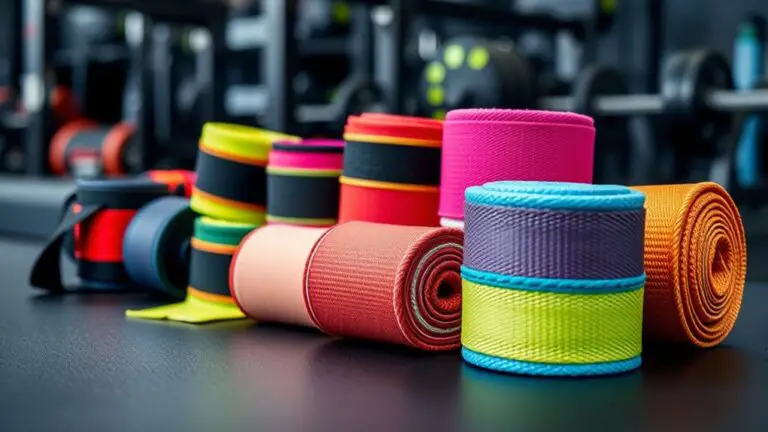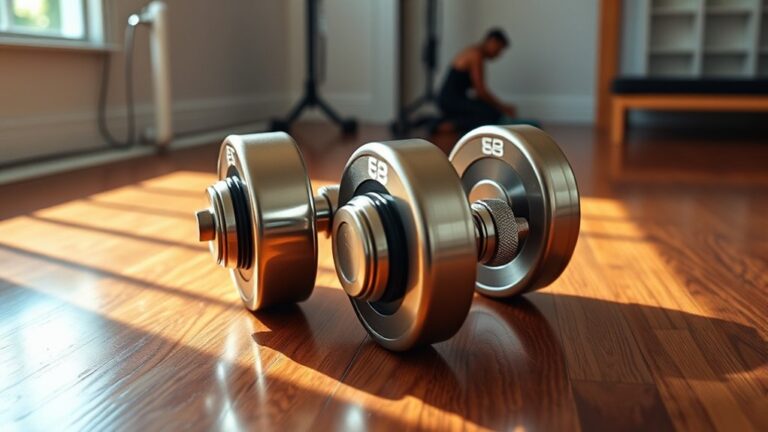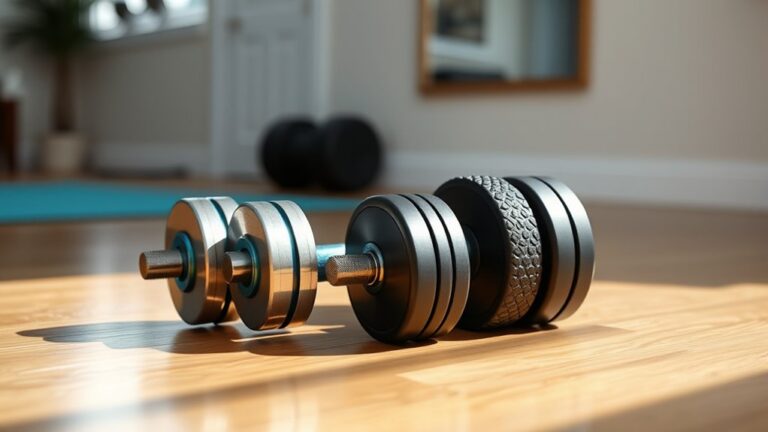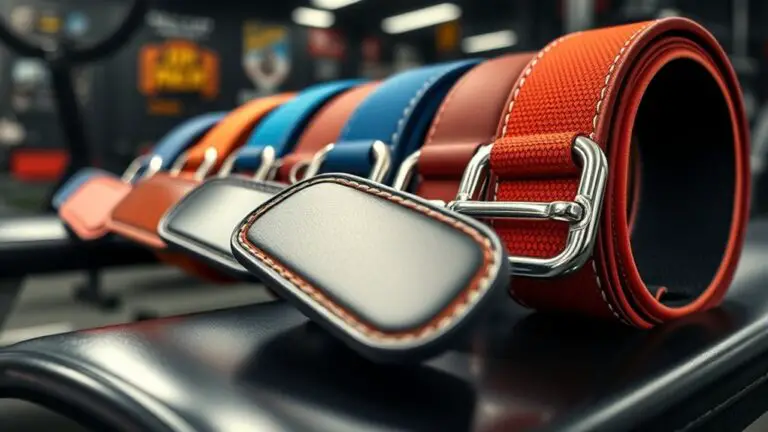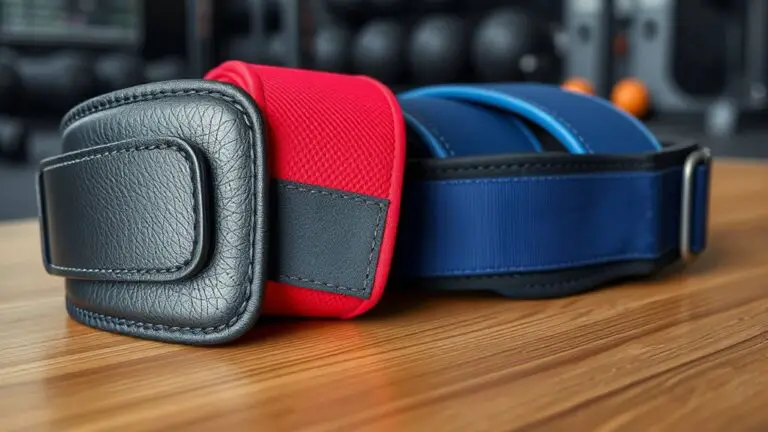The History of Gym Equipment: From Old-School to Modern Machines
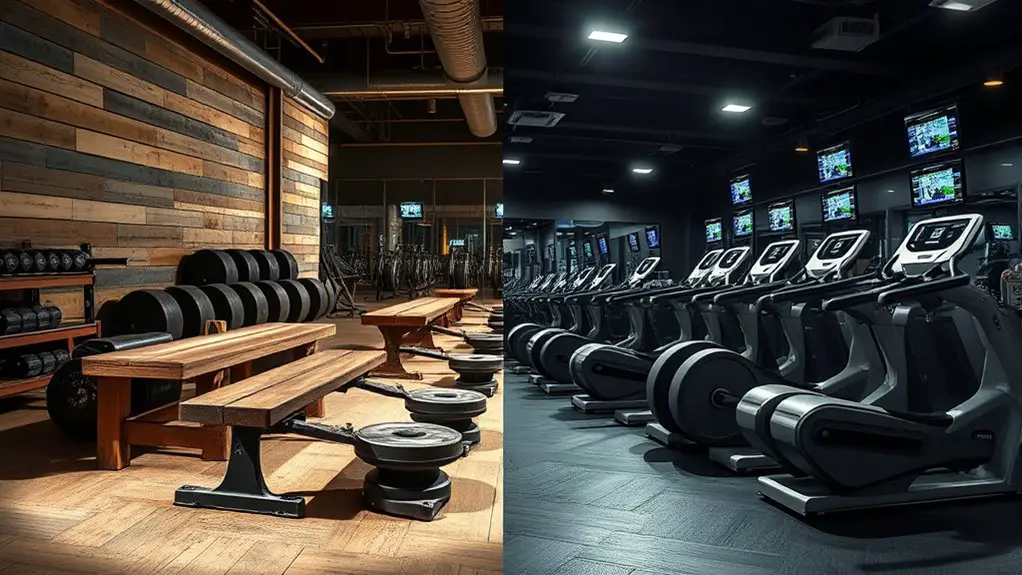
The history of gym equipment reflects our evolving approach to fitness, starting from ancient stone weights used by Greeks and Egyptians, to the mechanized devices of the 19th century initiated by innovators like Gustav Zander. The rise of bodybuilding and military fitness during the World Wars further shaped gym culture. Now, high-tech innovations are personalizing workouts through smart equipment and fitness apps. If you’re curious about the future trends in gym gear, there’s much more to explore.
The Origins of Strength Training: Ancient Practices
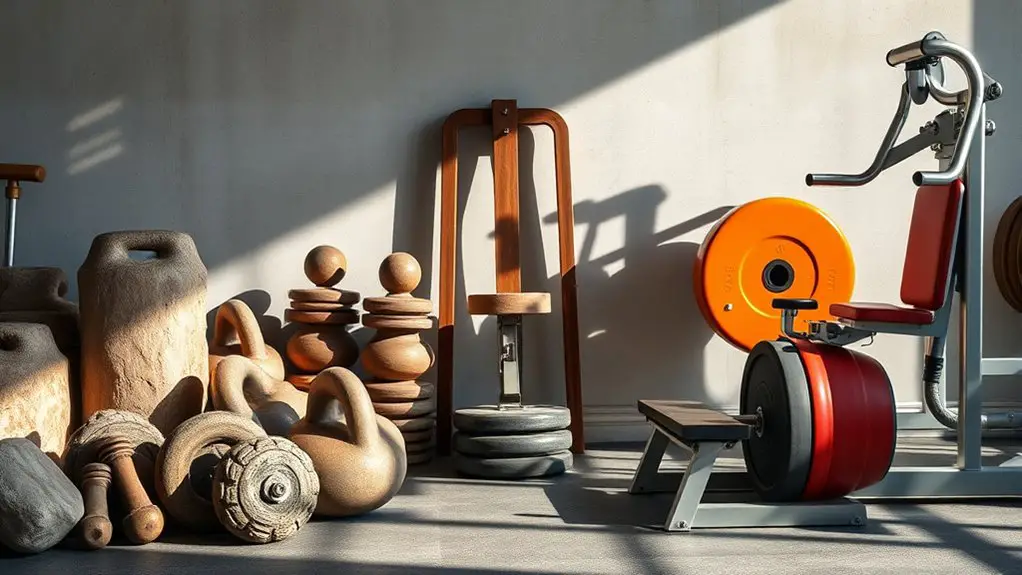
Although modern gym equipment may seem like a recent innovation, the roots of strength training trace back thousands of years to ancient civilizations. You might be surprised to learn that ancient weights, often crafted from stone or metal, were used by cultures like the Greeks and Egyptians for physical conditioning. These weights weren’t just tools; they were integral to fitness rituals that prepared warriors and athletes for competition.
In ancient Rome, gladiator training exemplified this approach, as fighters engaged in rigorous exercises to build strength and endurance. Their training often incorporated various cultural practices, emphasizing the importance of physical prowess in society. These early forms of strength training laid the groundwork for today’s fitness regimens, demonstrating that the quest for physical excellence has deep historical roots. By understanding these ancient practices, you can appreciate the evolution of strength training and its significance in shaping modern fitness culture.
The Birth of Modern Gym Equipment: The 19th Century Revolution
As the Industrial Revolution sparked unprecedented changes in society, it also paved the way for the birth of modern gym equipment in the 19th century. During this transformative period, advancements in exercise physiology began to emerge, influencing how people approached fitness. Individuals recognized the importance of structured exercise regimens to improve health and performance.
Innovators like Gustav Zander created mechanized devices aimed at enhancing strength training, making it more accessible to the masses. These early machines, such as the exercise bike and various resistance devices, laid the groundwork for what would evolve into sophisticated gym equipment.
Moreover, the rise of public gyms and fitness clubs reflected a growing awareness of physical well-being. Skipping rope became an increasingly popular exercise option, showcasing the blend of cardio and strength training that would shape modern fitness. You can see how the 19th century revolution not only changed industries but also redefined how society views fitness, establishing a foundation for future developments in gym equipment.
The Rise of Bodybuilding and the Equipment That Fueled It
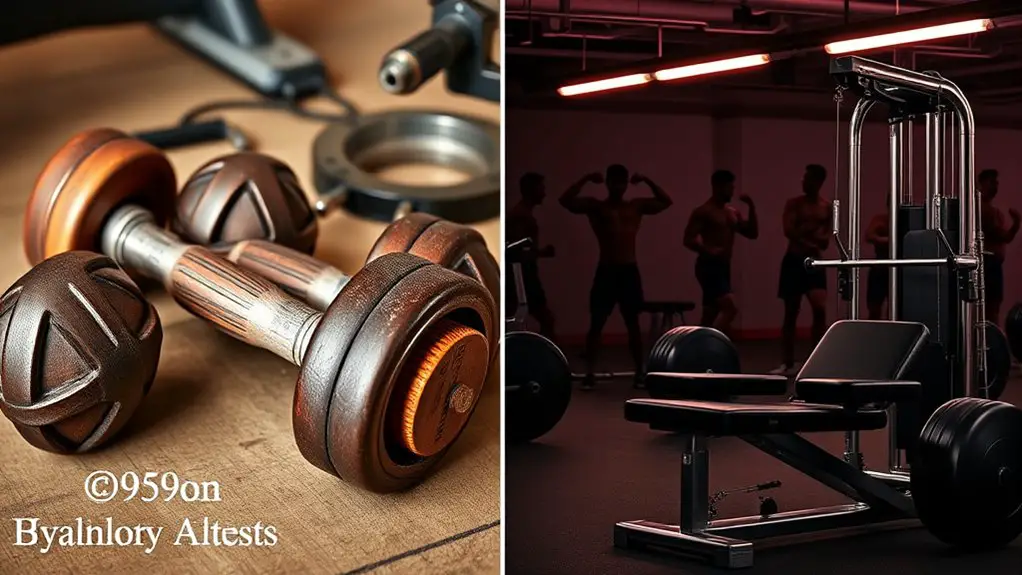
The burgeoning interest in fitness during the late 19th century set the stage for the rise of bodybuilding, a movement that would captivate audiences and reshape gym culture. As bodybuilding legends like Eugen Sandow emerged, they popularized the pursuit of a sculpted physique, which demanded specialized equipment. This led to significant equipment evolution, catering to the needs of aspiring bodybuilders.
The late 19th century’s fitness boom ignited bodybuilding, transforming gym culture and inspiring a new era of sculpted physiques.
Here are three key pieces of equipment that fueled this transformation:
- Barbells – Essential for developing strength and muscle mass, they became a staple in bodybuilding routines.
- Dumbbells – Versatile and easy to handle, dumbbells allowed for targeted muscle training, making them a favorite among early bodybuilders.
- Cable Machines – Introduced to provide constant tension during workouts, these machines enabled a variety of exercises that enhanced muscle definition.
Together, these innovations empowered a fitness revolution that shaped modern bodybuilding as it is understood. Additionally, skipping rope has become increasingly recognized for its ability to improve cardiovascular fitness, further complementing the strength training techniques utilized by bodybuilders.
The Impact of World Wars on Fitness and Gym Gear
While the world grappled with the devastating consequences of the two World Wars, the fitness landscape underwent significant changes that would shape gym culture for decades to come. Military fitness became a priority, leading to the development of rigorous training regimens for soldiers. Wartime workouts emphasized functional strength, endurance, and agility, with equipment often being improvised from available materials.
This shift influenced civilian fitness trends, as returning veterans sought ways to maintain their physical conditioning. The advent of calisthenics and bodyweight exercises became popular, reflecting the necessity of effective training with limited resources. As the wars progressed, home fitness began to take root, with simple gear like resistance bands and makeshift weights becoming household staples. These wartime adaptations not only changed how people viewed exercise but also laid the groundwork for future fitness movements, ultimately transforming gym gear and culture in the post-war era.
The 1970s Fitness Boom: Aerobics, Machines, and Home Equipment
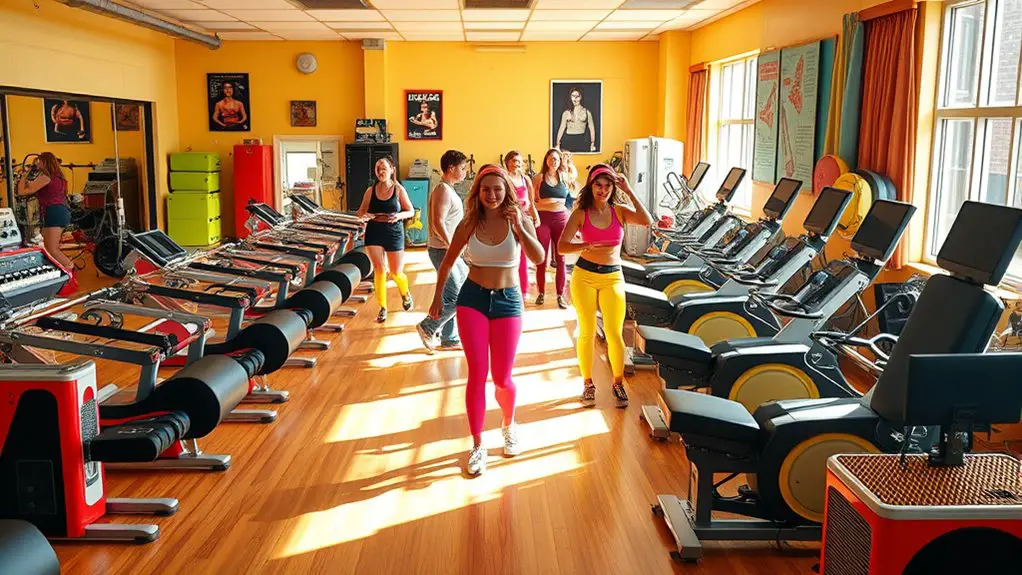
In the 1970s, fitness transformed dramatically with the rise of aerobics classes that made exercise fun and accessible for everyone. You saw a surge in home gym equipment, allowing people to work out on their own terms. This era not only shaped the way you approach fitness but also laid the groundwork for modern exercise culture. Ceiling fans became a popular addition in home gyms during this time to enhance comfort and air circulation while working out.
Rise of Aerobics Classes
As fitness enthusiasts embraced a newfound passion for health during the 1970s, aerobics classes emerged as a transformative force in the exercise landscape. The aerobics evolution brought rhythm and fun into workouts, blending fitness choreography with energetic music, making exercise more accessible and enjoyable.
Here are three key aspects that defined this rise:
- Group Dynamics: Social interaction fostered a supportive environment, encouraging participation and accountability.
- Diverse Formats: From high-impact to low-impact classes, there was something for everyone, catering to various fitness levels.
- Celebrity Instructors: Figures like Jane Fonda popularized aerobics, making it a cultural phenomenon and inspiring millions to join in.
These elements contributed considerably to the widespread appeal and success of aerobics during this iconic fitness boom.
Home Gym Revolution
The explosion of aerobics in the 1970s not only transformed group fitness but also sparked a significant shift toward home workouts, allowing individuals to create their personal fitness sanctuaries. As home gym trends emerged, more people recognized the value of exercising in the comfort of their own space. This era saw an increase in equipment accessibility, with manufacturers producing compact, affordable machines that catered to various fitness levels. You might’ve noticed the rise of multi-gyms, resistance bands, and exercise mats, all designed for convenient home use. This newfound focus on home workouts not only empowered individuals but also paved the way for future innovations in fitness, ultimately reshaping how people approach their health and wellness routines today.
The Introduction of High-Tech Innovations in the 21st Century
While many still rely on traditional weights and machines, the 21st century has ushered in a revolution of high-tech innovations in gym equipment that fundamentally alter how we approach fitness. These high tech advancements have made fitness personalization not just a possibility, but a reality. You’re no longer confined to one-size-fits-all solutions; instead, technology tailors workouts to your specific needs and goals.
Here are some key innovations transforming your gym experience:
- Smart Equipment: Machines that track your performance, adjust resistance, and provide real-time feedback.
- Wearable Technology: Devices that monitor biometrics, like heart rate and calories burned, giving you insights into your workouts.
- Virtual Reality Training: Engaging environments that enhance motivation and make workouts feel less like a chore.
These advancements not only enhance your training but also create a more engaging and effective fitness journey.
The Role of Digital Technology in Today’s Gym Equipment
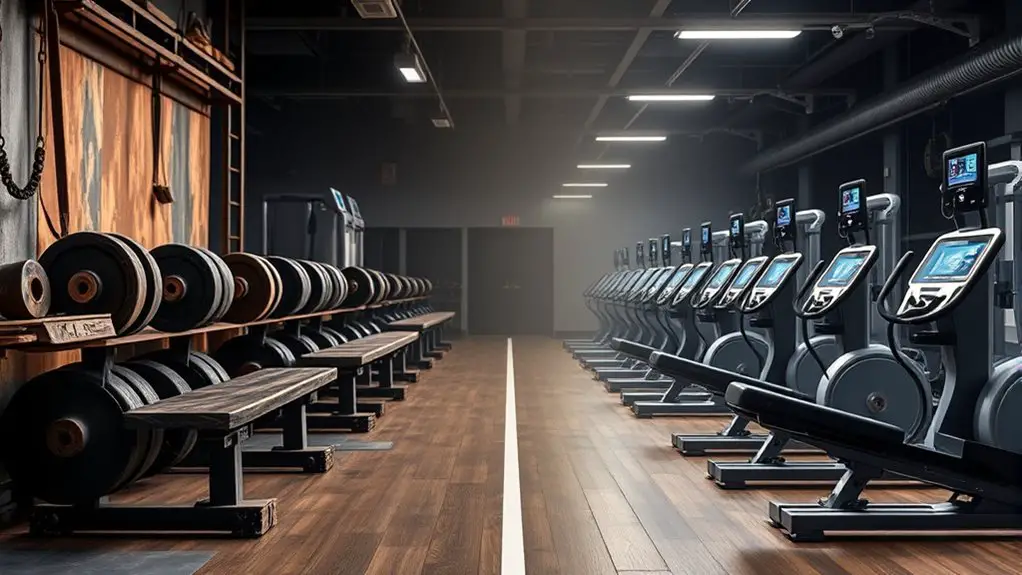
Today’s gym equipment has transformed considerably with the integration of digital technology, making workouts more interactive and personalized. You’re likely experiencing smart equipment that tracks your progress in real time, alongside innovative fitness apps that enhance your training experience. Virtual training is also changing the way you engage with fitness, offering diverse options that cater to your preferences and goals.
Smart Equipment Integration
As digital technology continues to evolve, smart equipment integration has transformed the landscape of gym equipment, enhancing how you engage with your workouts. With the rise of smart training, you can now personalize your fitness journey like never before. Consider how these interactive devices are reshaping your gym experience:
- Real-Time Feedback: Smart machines provide immediate performance analytics, helping you adjust your workouts on the fly.
- App Connectivity: Many devices sync with your fitness apps, allowing you to track your progress and set personalized goals.
- Virtual Coaching: Some equipment offers guided workouts and coaching, making it easier to stay motivated and accountable.
These innovations not only make workouts more efficient but also foster a deeper connection between you and your fitness routine.
Fitness Tracking Innovations
With the advent of advanced digital technology, fitness tracking innovations have become essential tools in modern gym equipment, fundamentally changing how you monitor and enhance your workouts. Wearable devices and fitness apps now provide real-time biometric tracking, allowing you to assess your heart rate, calories burned, and overall activity levels. Through data analytics, these tools offer personalized coaching that tailors workouts to your specific goals. Additionally, gamification strategies keep you motivated by turning workouts into engaging challenges. Health monitoring features help you track progress over time, while exercise feedback guarantees you’re performing movements correctly and efficiently. Together, these innovations create a more immersive and effective fitness experience, empowering you to reach your health and fitness aspirations.
Virtual Training Experiences
The rise of fitness tracking innovations naturally paves the way for virtual training experiences, greatly reshaping how you engage with gym equipment. These advancements not only enhance your workouts but also introduce new dimensions of motivation and guidance through virtual coaching.
Consider these key elements of modern virtual training:
- Immersive Workouts: You can now participate in workouts that simulate real-world environments, making exercise more engaging.
- Interactive Feedback: Real-time data allows you to adjust your form and intensity, optimizing your performance.
- Community Connection: You can join virtual classes, fostering a sense of belonging and accountability even from home.
With these features, your fitness journey becomes more personalized and effective, reflecting the cutting-edge integration of technology in gym equipment.
The Future of Gym Equipment: Trends and Predictions
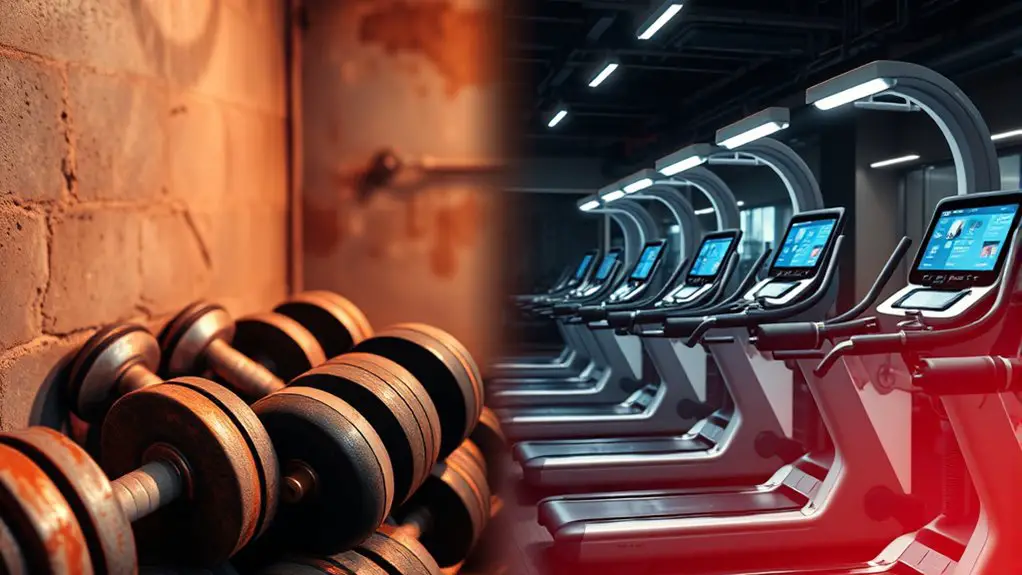
While many people still rely on traditional weights and machines, the future of gym equipment is rapidly evolving to meet the demands of modern fitness enthusiasts. You can expect a significant shift toward sustainable materials, as manufacturers aim to reduce their environmental footprint. Equipment made from recycled plastics or bamboo may soon become the norm, appealing to eco-conscious consumers.
Moreover, personalized workouts will dominate the landscape. Smart gym equipment equipped with AI will analyze your performance and adapt routines based on your specific goals and fitness level. Imagine having a treadmill that adjusts its incline and speed in real-time, responding to your heart rate.
Wearable technology will also enhance this experience, allowing for seamless tracking of your progress. As these trends unfold, your workouts will become more effective, enjoyable, and aligned with your individual needs, revolutionizing how you approach fitness.
Frequently Asked Questions
What Are the Most Iconic Gym Machines From the 20TH Century?
Did you know that over 70% of gym-goers use machines like the Smith Machine or Nautilus Equipment? These iconic gym machines revolutionized strength training in the 20th century. The Smith Machine, known for its safety and versatility, became a staple for weightlifters. Meanwhile, Nautilus Equipment introduced variable resistance, making workouts more efficient. Both have shaped modern fitness, helping people achieve their goals with innovative designs and functionality that you can still find in gyms today.
How Has Gym Equipment Affected Injury Rates Historically?
You might not realize how gym equipment has historically impacted injury rates. As equipment evolved, so did injury prevention measures. Older machines often lacked ergonomic designs, leading to strains and injuries. Modern advancements focus on biomechanics, improving safety and reducing risks. By incorporating adjustable features and user-friendly designs, today’s equipment minimizes the potential for injury, allowing you to train more effectively and safely. Understanding this evolution is essential for maximizing your workout experience.
What Role Do Personal Trainers Play in Gym Equipment Usage?
You might think personal trainers just show you how to use equipment, but their role goes much deeper. They employ personal trainer techniques to tailor workouts that fit your needs, ensuring safe and effective usage of gym equipment. Furthermore, they use client motivation strategies to keep you engaged and committed, helping you push through barriers. This combination maximizes your results and reduces the risk of injury, making your fitness journey more enjoyable and successful.
What Are Common Misconceptions About Old-School Gym Equipment?
You might think old-school gym equipment is outdated and ineffective, but that’s a misconception. The durability of vintage machines often surpasses modern alternatives, meaning they can withstand years of use. Many people overlook their effectiveness; simple designs like free weights and pulleys can yield impressive results. Embracing this equipment can enhance your workout routine, offering a unique blend of nostalgia and proven training methods that still deliver real gains today.
How Do Gym Equipment Designs Reflect Cultural Trends Over Time?
You might think gym equipment designs are just about functionality, but they actually reflect cultural influences and trends over time. As society’s values shift, so does the design evolution of workout gear. For example, the rise of fitness culture in the ’80s introduced vibrant colors and innovative materials. Today, minimalist designs emphasize sustainability and technology, showcasing a blend of aesthetics and purpose. This adaptability not only meets user needs but also mirrors broader societal changes.
